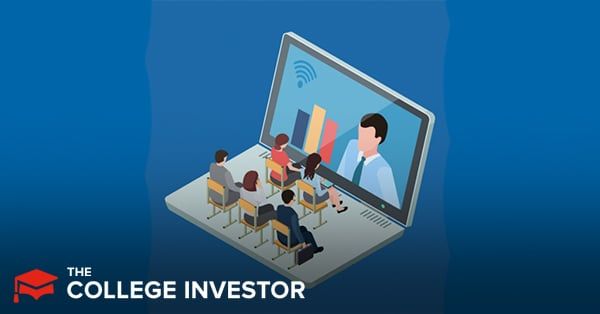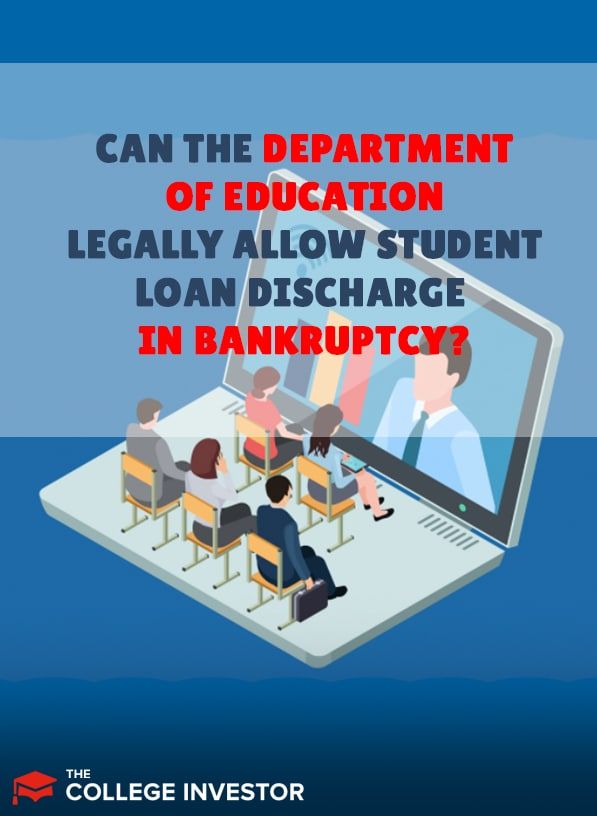
It's a common myth that student loans cannot be discharged in bankruptcy. However, the U.S. Department of Education has the legal authority to allow a borrower’s federal student loans to be discharged in bankruptcy, in certain circumstances. It has not, however, generally exercised this authority.
Instead, it often opposes undue hardship petitions. The general reasoning is that the availability of income-driven repayment plans provides sufficient financial relief for borrowers who face severe economic distress.
But is this reasonable, or should the Department of Education allow more student loan discharges in bankruptcy? Below, we discuss what we think, as well as a new bipartisan bill that could significantly change how students loans are handled in bankruptcy courts.
Editor's Note: Some dates and programs have been updated to reflect the end of the student loan payment pause and interest waiver.
Is Student Loan Discharge In Bankruptcy Legal?
Discharging student loans in bankruptcy is legally possible. But in practice, it's very rare. Only 0.04% of student loan borrowers who file for bankruptcy succeed in getting a full or partial discharge of their student loans. Many don’t even try to get their student loans discharged because of the expense and difficulty in qualifying for a discharge.
The U.S. Bankruptcy Code at 11 USC 523(a)(8) provides an exception to discharge of certain student loans. It blocks student loan discharge in bankruptcy unless the borrower is able to prove that keeping the debts "would impose an undue hardship on the debtor and the debtor’s dependents.”
Traditional Definitions Of Undue Hardship
Unfortunately, Congress did not define what it meant by 'undue hardship.' So it was left to the courts to decide when student loans loan discharge in bankruptcy would be legally allowed.
The courts have established two standards:
- The Brunner Test in the 2nd, 3rd, 4th, 5th, 6th, 7th, 9th, 10th and 11th circuits
- The Totality of Circumstances Test in the 8th circuit.
The 1st circuit uses both tests.
Brunner Test
The Brunner Test involves three prongs, all of which must be satisfied:
- The borrower must be currently unable to maintain a minimal standard of living for the borrower and the borrower’s dependents while repaying the student loans.
- The inability to repay the student loans must be expected to persist for a significant portion of the repayment term of the loans.
- The borrower must have made a good faith effort to repay the debt, demonstrating that the inability to repay the debt is due to factors beyond the borrower’s reasonable control.
Totality Of Circumstances Test
The Totality of Circumstances Test is similar, but does not include the third prong from the Brunner Test and is more flexible. Under the Totality of Circumstances Test, the court considers:
- The borrower’s past, present and future financial resources
- The reasonably necessary living expenses for the borrower and the borrower’s dependents
- Other relevant facts and circumstances affecting the borrower’s ability to repay the debt
Unlike the Brunner Test, there is no requirement that all three prongs must be met.
Both tests establish a very harsh standard for bankruptcy discharge of student loans. In fact, one bankruptcy judge in 1985 referred to the standard as requiring “a certainty of hopelessness.”
Ironically, this judge's description influenced some bankruptcy court judges to adopt even more stringent standards. Until very recently, many bankruptcy courts looked at the 'certainty of hopelessness' as the standard for determining whether a student loan discharge in bankruptcy was legally allowed rather than the standards actually required by the Brunner Test and the Totality of Circumstances Test.
Recent Definitions Of Undue Hardship
Although not necessarily the same as undue hardship, financial hardship has a similar definition. Financial hardship is defined in the regulations for administrative wage garnishment [34 CFR 34.3] as:
Financial hardship is determined by comparing costs incurred for basic living expenses for the borrower, the borrower’s spouse and the borrower’s dependents with all income available to the borrower from any source. [34 CFR 34.24] The regulations for administrative wage garnishment were added in 2003 and are based on the Debt Collection Improvement Act of 1996 (DCIA). [31 USC 3720D]
Although Congress did not initially define the term 'undue hardship,' the Bankruptcy Abuse Prevention and Consumer Protection Act of 2005 (P.L. 109-31) added a definition of undue hardship at 11 USC 524(m):
This is the equivalent of the first prong of the Brunner Test.
Duration Of Undue Hardship
The second prong of the Brunner Test requires the borrower’s inability to repay the debt must be likely to continue for a “significant portion” of the repayment term of the loan. Just how long is a significant portion of a loan’s repayment term?
The judge’s ruling in Brunner v. New York Higher Education Services Corporation (46 B.R. 752, S.D.N.Y. 1985) indicated that the repayment term is generally ten years:
But when the Brunner Test was issued, in 1987, student loans could be discharged after five years without requiring a showing of undue hardship. This suggests that a significant portion of the repayment term is less than five years. Otherwise, borrowers could have obtained a discharge after five years without needing to demonstrate undue hardship. A showing of undue hardship was necessary only if the borrower wanted to discharge their federal or private student loans in less than five years.
A five-year standard has been used in other discharge options for federal student loans, such as Total and Permanent Disability Discharge. See 20 USC 1087(a)(1). So it would be reasonable for the U.S. Department of Education to decide that student loan discharge in bankruptcy is legal when the borrower’s situation is of a permanent character and has lasted (or is expected to last) for at least five years.
Proposed Legal Changes To Student Loan Discharge In Bankruptcy
Before 1976, student loans could be discharged in bankruptcy without a waiting period and without requiring the borrower to demonstrate undue hardship prior.
But a 5-year waiting period was added by the Education Amendments of 1976 for borrowers who could not demonstrate undue hardship. The waiting period was increased from 5 years to 7 years in 1990 through the Crime Control Act of 1990 and eliminated in 1998 through the Higher Education Amendments of 1998.
This left demonstrating undue hardship as the only option for discharging student loans in bankruptcy. But Senators Richard Durbin (D-IL) and John Cornyn (R-TX) introduced the FRESH START Through Bankruptcy Act of 2021 on August 4, 2021.
The FRESH START ACT would restore the ability of borrowers to discharge federal student loans after a 10-year waiting period without demonstrating undue hardship. And under certain circumstances, the college attended by the student when the loans were borrowed would be required to repay as much as half of the discharged debt.
Related: This is very similar to our chargeback model in our proposal to reform student loan debt.
Under this bipartisan legislation, the 10-year requirement would not count “any suspension of the repayment period.” But borrowers would remain eligible to discharge their student loans sooner if they're able to demonstrate undue hardship.
The choice of a 10-year waiting period is, perhaps, based on the idea that a 10-year repayment term is a reasonable amount of time to be repaying student loan debt. It is also the standard repayment term for a federal education loan.
Recent Student Loan Bankruptcy Updates
In November 2022, the Department of Education, in conjunction with the Department of Justice, announced that they will be "not blocking" petitions for bankruptcy and they will set clear guidelines for their attorney's in dealing with student loan bankruptcy proceedings.
This isn't a complete win for borrowers, but it should make the process of getting a bankruptcy discharge easier for those who really need it.
See the full announcement here.
Reasons For The Department Of Education To Oppose Fewer Undue Hardship Discharge Petitions
The U.S. Department of Education can choose to not oppose undue hardship petitions for the bankruptcy discharge of federal student loans. It should exercise this authority more often. Here are a few recommendations for when undue discharge petitions for student loan should be allowed without opposition.
Cost Of Collection
If the cost of litigation exceeds one third of the potential recoveries, the U.S. Department of Education should not oppose the undue hardship petition. This should be a mandatory standard and not advisory or discretionary in nature.
"It is a waste of taxpayer resources to litigate a case when the actual amount recovered will be less than the cost of the litigation."
Moreover, when evaluating potential recoveries, the U.S. Department of Education should consider the likelihood of collecting the loan and the amount that is likely to be collected. It should not assume that the full amount of debt will be collectable if the discharge petition is denied. It is a waste of taxpayer resources to litigate a case when the actual amount recovered will be less than the cost of the litigation.
Borrower Unable To Repay Debt
When deciding whether to oppose an undue hardship petition for bankruptcy discharge, the U.S. Department of Education should also consider the:
- Borrower’s current and future income
- Borrower’s age and health
- Amount of time that has passed since the debt was incurred
For example, the U.S. Department of Education could adopt a standard that allows undue hardship discharge for borrowers who are age 65 and older. More than a third of elderly borrowers age 65 and older are in default on their student loans.
The U.S. Department of Education should also consider whether the borrower dropped out of college and was unable to complete their education. In these cases, borrowers have the debt but no degree that can help them repay that debt.
The U.S. Department of Education could also allow bankruptcy discharge for borrowers who are living under the poverty line and who are likely to continue in such a low-income status for at least five years.
Borrowers With High Necessary Expenses
The U.S. Department of Education should also not oppose an undue hardship petition when the borrower has high ongoing medical and disability-related expenses for themselves or a dependent.
Total and Permanent Disability (TPD) does not apply when it's the borrower’s dependent who is disabled, as opposed to the borrower. Nevertheless, borrowers may have high medical and disability-related expenses that affect their ability to repay their student loans. Likewise, the borrower may be unable to work a full-time or better-paying job because of the need to take care of a disabled child or elderly parent.
If the borrower has a severe disability that seems likely to qualify for a TPD discharge, the U.S. Department of Education should not oppose the undue hardship discharge. The availability of disability discharges and other accommodations should not bar a disabled borrower from seeking an undue hardship discharge.
The U.S. Department of Education should also consider whether the financial settlement from a divorce or separation significantly affects the borrower’s ability to repay the debt. The Tax Cuts and Jobs Act of 2017 eliminated the above-the-line deduction for alimony payments for people who get divorced in 2019 or a later year.
This means that adjusted gross income (AGI) is higher for taxpayers who pay alimony. Accordingly, the payments made under an income-driven repayment plan (which base discretionary income on AGI) may no longer reasonably reflect the borrower’s ability to repay their student loans.
Why Some Object To Allowing More Student Loan Discharges In Bankruptcy
Not everyone agrees that student loan discharge in bankruptcy should be legally allowed more often. Two of the most common reasons that people give for why the Education Department should continue to oppose student loan discharge in bankruptcy as often as it has in the past are:
- The availability of income-driven repayment plans
- The legal ability to use Social Security offsets to cover student loan debts instead
But, as we explain below, both of these arguments break down at some level. Let's take a closer look.
Income-Driven Repayment Plans
The availability of income-driven repayment (IDR) plans with a zero monthly payment for borrowers doesn’t prevent someone from meeting the definition of undue hardship discharge. In fact, could can argue that a borrower with a zero monthly payment under an IDR plan has demonstrated undue hardship.
The poverty line is a minimal standard of living, where the family has no discretion in how income is spent to pay for necessary living expenses. A borrower who is living below the poverty line is unable to pay anything toward their student loans. Moreover, if the borrower were able to use an IDR plan with income less than 150% of the poverty line, the potential recovery is zero and the cost of litigation clearly can't be recovered.
Even a non-zero monthly student loan payment under an IDR plan may be unaffordable when considered in the context of the borrower’s net income and actual necessary expenses. Also, if the monthly student loan payment is low, the cost of servicing the loan may exceed the payments made by the borrower. This is not cost effective for the federal government.
When a borrower's student debt under an IDR plan is negatively amortized, it persists and can grow without bound. This may prevent the borrower from getting a job and renting an apartment, as employers and landlords often consider a person’s credit history.
This is inconsistent with the goal of the U.S. Bankruptcy Code in providing borrowers with a fresh start by wiping the slate clean. A bankruptcy remains on the borrower’s credit history for 10 years, while student loans can last for decades.
Social Security Offsets
The offset of Social Security disability and retirement benefit payments to repay defaulted federal student loans is a morally bankrupt public policy.
Most recipients of Social Security benefits are on fixed income and rely on the Social Security benefits to pay for food, medicine, housing and other basic living expenses. If Social Security is a borrower’s only source of retirement income, offsetting Social Security benefits represents an undue hardship on the borrower and the borrower’s dependents.
When the federal government gives with one hand while taking back with the other, it places people in dire financial circumstances. They may have to choose between paying for medication and paying for food.
The U.S. Department of Education should stop offsetting Social Security disability and retirement benefits. Or, at the very least, they should use means-testing to determine when offsetting these benefits is not entirely unreasonable.
Final Thoughts
The Education Department suspended collection activity on defaulted federal student loans during the payment pause and interest waiver, and for the 12 months after repayment has resumed.
So starting October 1, 2024, the U.S. Department of Education will once again garnish wages, intercept income tax refunds and offset Social Security disability and retirement benefits to repay defaulted federal student loans. And thanks to the current "undue hardship" standard, it will be difficult for those borrowers to receive a legal student loan discharge in bankruptcy.
If passed, the FRESH START bill would make student loan discharge in bankruptcy legal after 10 years without requiring borrowers to demonstrate undue hardship. And regardless of how the FRESH START bill fares, we think that there are several legitimate reasons for the Department of Education to oppose fewer undue hardship petitions from student loan borrowers.
Note: Fresh Start is also the name of the program that the Biden Administration has dubbed for the plan to help borrowers in default before the pandemic.

Mark Kantrowitz is an expert on student financial aid, scholarships, 529 plans, and student loans. He has been quoted in more than 10,000 newspaper and magazine articles about college admissions and financial aid. Mark has written for the New York Times, Wall Street Journal, Washington Post, Reuters, USA Today, MarketWatch, Money Magazine, Forbes, Newsweek, and Time. You can find his work on Student Aid Policy here.
Mark is the author of five bestselling books about scholarships and financial aid and holds seven patents. Mark serves on the editorial board of the Journal of Student Financial Aid, the editorial advisory board of Bottom Line/Personal, and is a member of the board of trustees of the Center for Excellence in Education. He previously served as a member of the board of directors of the National Scholarship Providers Association. Mark has two Bachelor’s degrees in mathematics and philosophy from the Massachusetts Institute of Technology (MIT) and a Master’s degree in computer science from Carnegie Mellon University (CMU).
Editor: Robert Farrington Reviewed by: Chris Muller
